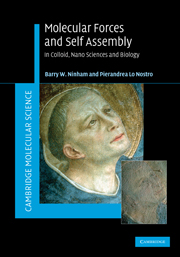Book contents
- Frontmatter
- Contents
- Preface
- Part I Molecular forces
- Part II Self assembly
- 9 Self assembly: overview
- 10 Self assembly in theory and practice
- 11 Bicontinuous phases and other structures: forces at work in biological systems
- 12 Emulsions and microemulsions
- 13 Forces at work: a miscellany of issues
- Index
- References
11 - Bicontinuous phases and other structures: forces at work in biological systems
from Part II - Self assembly
Published online by Cambridge University Press: 06 January 2011
- Frontmatter
- Contents
- Preface
- Part I Molecular forces
- Part II Self assembly
- 9 Self assembly: overview
- 10 Self assembly in theory and practice
- 11 Bicontinuous phases and other structures: forces at work in biological systems
- 12 Emulsions and microemulsions
- 13 Forces at work: a miscellany of issues
- Index
- References
Summary
Cubic phases
Introduction to cubic phases
With any curved bilayer or topologically closed region such as single- or multi-walled vesicles, there is an inevitable conflict due to internal packing constraints (cf. Fig. 9.8 and 10.2).
In the energetically optimal configuration, lipids packed into the outer bilayer have normal curvature. The hydrocarbon chains are stretched. By contrast, the inner surfactants have reverse curvature. The chains are compressed. So although the interior of a bilayer can be considered fluid-like, above the Krafft (gel) temperature of the lipid it is asymmetric. As we have seen, and re-summarize, this necessary frustration has several consequences. The first is that when the radius becomes small enough, the interior layers of a multilamellar vesicle structure must collapse into aggregates different in structure to that of a bilayer. The interior can be micelles. Or it can be bicontinuous. This gives rise to supra-aggregation as a normal and expected state of self assembly. Or else the interior can be empty and surfactant-free. The second consequence is that a single-walled bilayer or vesicle has to have a radius (typically 100 nm) sufficiently large to accommodate this additional internal packing condition.
There is another way that the frustration can be relieved.
The bilayer-forming lipids or surfactants have a surfactant parameter around vH/(aPlH) ∼ 1, or <1. The average of the principal curvatures at the interface is zero for a flat bilayer.
- Type
- Chapter
- Information
- Molecular Forces and Self AssemblyIn Colloid, Nano Sciences and Biology, pp. 308 - 328Publisher: Cambridge University PressPrint publication year: 2010



